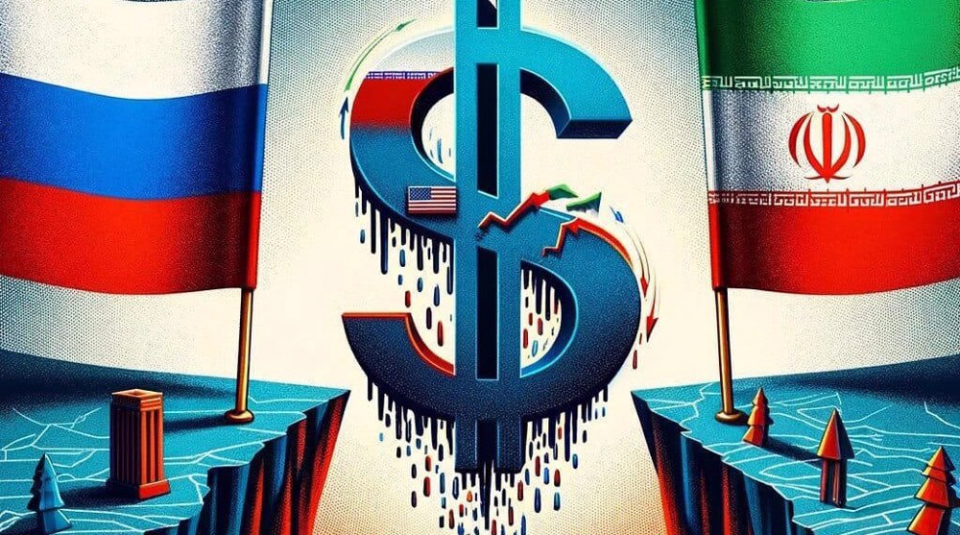Last week, Iran and Russia announced to have finalized an agreement to trade in their local currencies instead of the US dollar. The agreement signed during a meeting between the governors of the two countries' central banks in Russia enables banks and economic actors to use infrastructures including non-SWIFT interbank systems to deal in local currencies.
Both Iran and Russia are subject to US sanctions, which have motivated the emerging allies to craft their own path in the global economy and break away from traditional monetary systems as countries around the world shift away from the greenback.
In recent years, Russia and Iran have stepped up oil sales in alternative currencies, and found buyers in China, India and elsewhere that are happy to buy these exports often at lower prices because paying in a domestic currency rather than dollars lowers transaction costs.
Last October, Royal Bank of Canada reported that 25% of Russia's trade with countries other than China was settled with the Chinese yuan.
The US dollar's dominant role in the international monetary system has enabled the country to act as the world’s watchdog and use threats of exclusion from the dollar-based financial system as a political leverage against the nations which it does not see eye to eye.
Seeing a risk that Washington could act similarly against them in the future, other governments have also moved to reduce their dependence on dollar payments.
Brazil, the United Arab Emirates and Saudi Arabia have recently taken steps laying the groundwork for trade that sidesteps the dollar.
An Indian refiner took in a shipment of Emirati oil and paid for in Indian rupees after their governments signed a deal in the summer to trade in their own currencies. Brazil and China completed their first local-currency commodity transaction in the fall, involving a shipment of Brazilian pulp.
And in November, China and Saudi Arabia reached a currency swap agreement worth around $7 billion, marking another step in the dedollarization trend.
China imported $65 billion worth of Saudi crude oil in 2022, according to Chinese customs data. If Beijing can successfully develop a non-dollar oil trading architecture with Saudi Arabia, it will be able to withstand financial sanctions directed at China’s oil imports.
China’s leaders know that its dollar reserves, like Russia’s, can be frozen, and the holdings and transactions of Chinese firms frozen and blocked. Such moves would place extraordinary stress on China’s economy, which is more complexly intertwined with global trade than Russia’s.
Oil is at the center of the shift. A JPMorgan report in September confirmed that more and more of the oil trade is taking place with currencies other than the dollar.
Russia has been selling in Chinese yuan, Russian rubles, Emirati dirhams and Indian rupees, according to the Institute of International Finance. Iran, which mostly sells oil to China in yuan, also has stepped up exports.
Last year, Pakistan began paying for Russian oil shipments in the Chinese currency amid a dollar shortage in the South Asian country.
However, the most serious challenge to the dollar’s dominance is coming from BRICS countries, thanks to the bloc's growing size and influence over global trade.
The group of emerging countries was formed in 2006 by Brazil, Russia, India and China, with South Africa joining in 2010. BRICS rang in 2024 by inducting five new countries including Saudi Arabia, the United Arab Emirates, Egypt, Iran, and Ethiopia.
However, more countries have submitted applications to join it and its de-dollarization mission, including as many as 16 new nations which may join BRICS in 2024.
Egypt, Ethiopia, and Saudi Arabia surround the Suez Canal, a key passage for goods to flow into international markets that gives BRICS influence over 12% of all global trade.
The group has now a combined population of about 3.5 billion people, with a combined economy worth over $28.5 trillion or about 28% of the global economy.
In August last year, Brazil's President Luiz Inacio Lula da Silva called for the BRICS nations to create a common currency for trade and investment between each other.
BRICS is also looking to create their own internet services and not depend on American technology for news and social media.
Last summer, 10 ASEAN countries agreed to stop trading in the US dollar and use native currencies for cross-border settlements.
The bloc compromises Brunei, Cambodia, Indonesia, Laos, Malaysia, Myanmar, Philippines, Singapore, Thailand, and Vietnam which are likely on the list of applicants to join BRICS.
In a recent op-ed for the Foreign Policy magazine, former White House economist Joe Sullivan warned that a BRICS currency could topple the dollar and put it in a similar position as the British pound, which slipped from international dominance in the 1800s.
Sullivan touched on major sway of the bloc in commodities markets where Saudi Arabia, Iran, and the UAE are among the world's top exporters of fossil fuels, while Brazil, China, and Russia are major exporters of precious metals.
Saudi Arabia, Sullivan said, owns over $100 billion in US bonds, which has helped bring BRICS' total holdings in US Treasury over $1 trillion.
If countries ditch the dollar, the currency will circulate back to the US and lead to inflation where the prices of housing, rent, and basic daily necessities will skyrocket and become unaffordable.
The remaining countries which have not removed the dollar from their economic cycle would have to share the burden with the United States.
De-dollarization would also neutralize US sanctions against countries such as Iran and Russia and ease up commercial exchanges among them.
Moreover, it would lead to economic pressure on Western countries, prompting Europe to carry out trade in euro and any currencies other than the dollar, sending the greenback further into a tailspin.

















